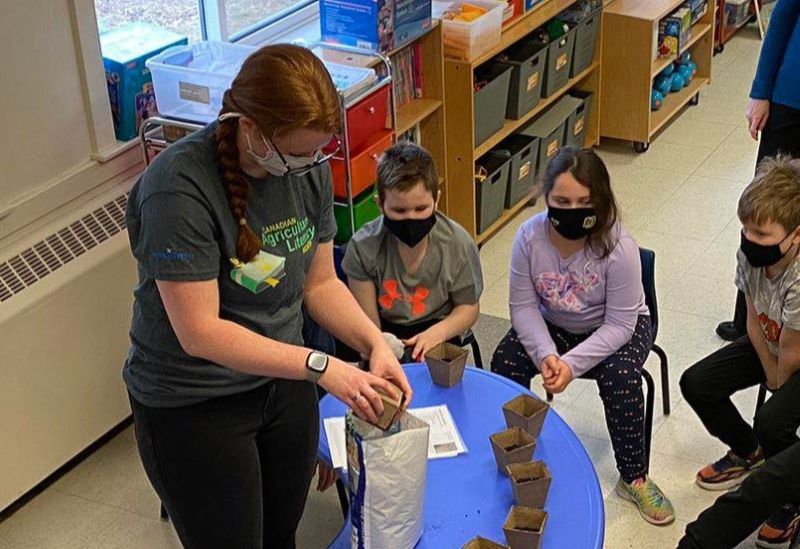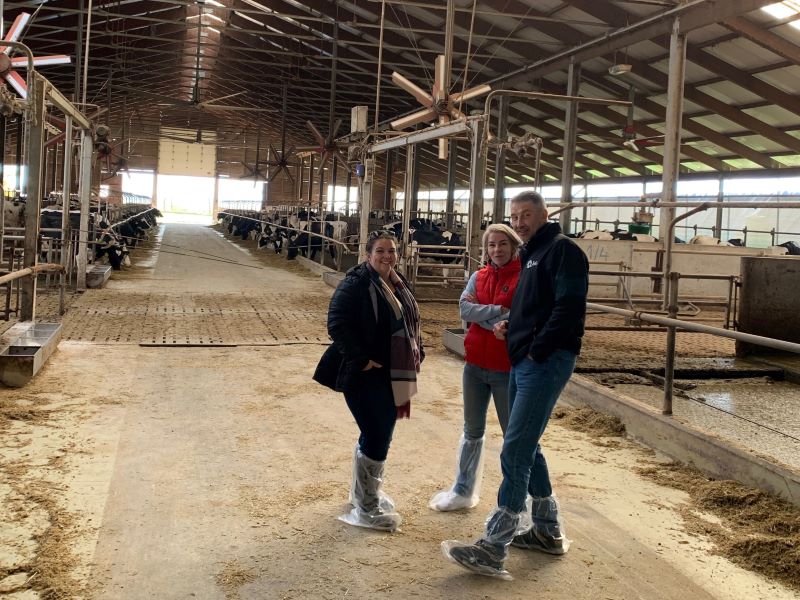Every 18 months, a group of 20 to 25 young Canadians working in the agriculture and agri-food sector is selected to join forces and make an impact on the world. With diverse backgrounds and a multitude of interests, these individuals meet frequently throughout their terms to provide advice, exchange information, and give direction on policies and programs that impact the sector. They meet regularly with the Minister of Agriculture and Agri-Food to share their insight into the diverse world of agriculture.
Who are they? The Canadian Agricultural Youth Council (CAYC), of course! From showcasing the broad range of careers within the sector to informing the public about how their food is produced, members of the CAYC understand the importance of education in keeping agriculture moving forward. Read the stories of four members who have been members of the CAYC since its launch in 2020, and are helping the industry grow stronger by sharing their knowledge with Canadians, both inside and outside the sector.
Lauren Peters Withrow – Truro, Nova Scotia
A blending of worlds
Some of Lauren Peters Withrow’s fondest memories were helping her parents prepare dinner. From cutting vegetables to mixing sauces and marinades, watching all the ingredients come together in one meal was always a fun adventure. While other kids begged to stay out longer to play, Lauren was happy to sit at the table for dinner, relishing the different flavour combinations on her plate.
The passion for cooking and baking only grew as she got older. In high school, she took classes that deepened her knowledge of food science. She joined 4-H, an agriculture-based youth organization, and completed projects that helped her learn new techniques and exciting ways to cook familiar foods. Outside the kitchen, she worked at an egg farm alongside her sister, watching the other side of food production. The curiosity and joy continued, choosing high school classes that taught her the science of nutrition and the transformative powers of yeast and microorganisms. Food was her future.
But as she learned more about the intensity of some culinary careers, Lauren started to wonder how to pursue her passion: “When I pictured life after high school, my original plan was a diploma in the culinary arts. However, I realized that it didn’t align with the lifestyle I wanted.” Not wanting to drop her dreams of dicing and chopping completely, she began exploring the other options to pursue her passion. There had to be a way to blend her culinary interests with business, to learn more about the practical, theoretical, and economical sides of food. After all, agriculture and food supply were global industries.
She found that perfect blend in the International Food Business Program at Dalhousie University.
Four years and many unforgettable experiences later, Lauren felt she understood the interlinked complexities of the food supply chain. The agriculture and agri-food sector was so vast and diverse, and yet, like her, many youth weren’t aware of the opportunities waiting for them. After some time working in the industry, Lauren realized she wanted helped others find success like she did. That’s when she stumbled upon a job that would take her back to school.
Food for thought
Lauren’s jaw dropped as she read the job’s description. Community education manager: help build healthy and sustainable communities across Atlantic Canada by sharing your agricultural knowledge with educators, students, community groups, and the public. It was as if the position was perfectly tailored to her, allowing her to draw on all her life experiences to help others learn more about the industry through field trips, hands-on activities, and educational resources.
She eagerly applied for the job and soon enough, she was walking along the research fields and red brick buildings of Dalhousie’s Agricultural Campus once again. While she shared knowledge with people of all ages from across Atlantic Canada, her lessons with students were always a treat. Watching the students’ eyes light up in amazement as they realized all the hard work and co-ordination required to create some of their favourite foods never got old.

For some students, Lauren’s lessons opened new doors of possibilities, learning of jobs they never knew existed. But for Lauren, it was enough to know that by the time they boarded the school bus at the end of the day, they knew a little bit more about their food and the passionate people that help put it on their plates. “They're the next generation of consumers, so why not start talking to them about where their food is coming from?” asks Lauren. “They may not be the ones shopping for their groceries, but they’re still the ones choosing what goes on their plate.”
Lauren’s not finished learning yet. There’s still so much to discover in the food industry, and she’s enjoying connecting with others in the CAYC to hear their experiences. With their help, she’s making an impact for youth in the sector on a national level.
Chantele Gouliquer – La Broquerie, Manitoba
Eyes on the prize

Leaning against the fence, Chantele Gouliquer watched the horses wander and graze in the paddock. A smile slowly crept across her face as she thought about all her treasured memories with her four-legged friends. The nervous excitement of a show. The serene rides through forested trails. All the feelings she held close to her heart only made her more certain that there was only one answer to the question “what do you want to be when you grow up?”: “a veterinarian.”
But in all honesty, Chantele didn’t think another career was possible. She knew she wanted to work with animals, and that was the clearest path to her dream. And the more she said it, the more she believed it.
Years went by, and Chantele’s answer never changed. When it came time to apply to university, she eagerly sent out her applications and eventually enrolled in the University of Alberta’s animal health program. The program’s focus would set her up for a successful application to veterinary school and, hopefully, a successful career. So at the end of summer, she packed her belongings, squeezed them into her parents’ car, and headed to Edmonton.
While Chantele loved her classes, she felt that her dream of being a vet might not become a reality. The application process for veterinary school was intense, and she worried her good grades might not be good enough. But it was her part-time job at a vet clinic that gave her a peek behind the curtains and cemented her decision. Every day at the clinic was an emotional roller coaster. Sure, there were the highs of helping an animal in need or giving a puppy its first checkup, but there were also the lows: the reality that not every illness could be treated. “It was too hard on my heart,” Chantele recalls. “I realized very quickly that I did not want to do that all day.”
With vet school no longer an option, Chantele wasn’t sure where to turn. That is until one course forced her to step into a new world.
An unexpected journey
Animal agriculture changed her future. During a mandatory course in her program, Chantele was suddenly plunged deep into an unfamiliar world. The students spoke in what seemed like another language—one of farm succession, breeding procedures, unimaginable careers. Each class intrigued her more and more, yet the hushed whispers amongst her peers made her nervous. Many of her classmates knew exactly where they’d be after graduation, yet Chantele found herself questioning where she would begin.
Fortunately, the class itself was delivered in an unusual way. Instead of the standard static lecture, the professors took a different approach, one that would immerse the students in the agriculture sector. “The idea was that they would introduce us to as many people as possible across the sector, and along the way, we would hopefully find our niche,” Chantele recalls. Every week, Chantele learned more, and every week she became more eager to get out of the classroom and get her hands dirty.
Opportunity was everywhere: working in a lab at the University opened her eyes to the power of research; finding solutions on farms was a rush of excitement; and supporting producers by implementing new tools and procedures brought her unprecedented satisfaction. The career trajectory she’d always envisioned didn’t just shift, it was completely replaced by a deep desire to learn everything and anything about the world of agriculture. Chantele didn’t just want one small sliver in the farms and fields. She wanted all of it.
The youth council gives her a taste of the policy within agriculture and has encouraged her to keep trying new jobs and find new dreams. Joining the CAYC did more than just expand her understanding of the sector, it also allowed Chantele to participate in passion projects and working groups. One particular initiative spoke to Chantele as a new entrant to the farming community: showing youth in Canada the wide spectrum of career opportunities in the world of agriculture and the pathways to get there. Through this resource and collaborating with other agricultural education groups, Chantele hopes to demystify careers in the agriculture and agri-food sector, making it easier for students to find a fulfilling career.
Vicki Brisson – Russell, Ontario
Watch and learn
As a kid, Vicki Brisson loved asking her parents questions about their family's dairy farm. They always answered, happy to indulge her growing curiosity in their daily tasks. But the real excitement began whenever she heard the crunch of tires on gravel announcing the arrival of the veterinarian.

“Any time the vet truck would pull up on the farm, I would rush to the barn just to see what they were doing,” Vicki recalls. “I was a sponge—I wanted to learn everything! They had such a different, complex perspective on the animals.”
Vicki watched keenly as the vet inspected their cows. From a collection of observations, the vet formed diagnoses and shared treatment plans with her parents. But what excited Vicki more than curing illnesses or injuries through medicine or surgical procedures were the preventative treatments. The very thought of preventing a disease before it could spread through a herd excited her.
When it eventually came time to choose her career, Vicki knew she wanted to stay in the dairy sector. Farming itself wasn’t for her. It was a job that required knowledge on a breadth of topics: managing people and investments, growing crops, and utilizing new technology, just to name a few. But that wasn’t where she saw her future. Still, the complexities of working with cows was compelling. Farmers already juggled so much, and she wanted to help them keep their herds healthy.
A balanced meal
As she learned more about animal nutrition, Vicki realized that dairy cows had a lot in common with high performance athletes. Like a runner speeding down the track, cows use a lot of energy during milk production. Every cow has different dietary needs to meet the optimal level of health, and she was fascinated by this puzzle in digestion.
That’s when it clicked for her. To get the best food possible for the cows, she had to focus on the process at the microscopic level.
Working with farmers and nutritionists as a ruminant (grazing animal) technical services manager, Vicki uses the power of vitamins and nutrients to help nutritionists formulate the perfect balance in feed. Farmers have different goals for their herds, whether that be preventing certain diseases or producing more milk, and she uses micronutrients (nutrients needed in small amounts) to find the optimal ratios for cows’ diets.
But in order for these small but mighty nutrients to be most effective, she needs to understand the fuller picture of the farm.
For Vicki, listening is key. “It’s important that I understand a farmer’s reality. Whenever I meet someone, whether it’s the first time or I’ve known for ages, it’s important to just listen to what they say,” says Vicki. “You can learn a lot from listening to the little details in a conversation.”
Knowing a farm's current practices allows Vicki to provide them with information and recommendations to help get the most out of their feed. Each day is so rewarding, and she loves connecting with farmers to help with their livestock, but she always felt that there was more she could do. Her parents were always conscious of how to give back to their community, something Vicki admired and wanted to continue herself.
When she heard that Agriculture and Agri-Food Canada (AAFC) was launching the CAYC, she felt that it was her opportunity to give back while helping develop the future of the sector. Through connecting with other youth council members, Vicki expanded her network and learned about new sides of the industry. She hopes that by connecting with members of the youth council and sharing their stories, they can highlight the diversity of the sector and encourage other youth to share their voices and find success.
Sara Kate Smith – Barriere, British Columbia
Beyond the barn
Growing up on a farm in rural British Columbia, Sara Kate Smith always had an interest in agriculture, but it wasn’t until she joined her local 4-H club, an agriculture organization focused on youth development, that she really saw the breadth of the sector. It gave her incredible opportunities. From organizing provincial conferences to representing the organization to advocating for youth on the international stage at the United Nations—the more she learned, the more she wanted to understand the solutions needed for the sector.

Because there was one statistic she couldn’t get out of her head: the sector participation rate for youth, new entrants, and underrepresented voices such as women and racialized groups. Always low. Never budging. Year slipped by, but nothing changed.
It was a constant reminder of the challenge the sector faced, and the work that still needed to be done.
“The policies put in place now will directly impact the youth and new entrants who will be working in the landscape shaped by those policies in the coming years,” says Sara. “If we don’t bring them to the table now, then we aren’t adequately engaging with the future of the industry.”
It was a tall order. There were so many jobs that required unique and specialized skillsets. The software developers creating apps to help farmers track data. The researchers developing new crop varieties for a changing climate. The procurement teams sourcing sustainable ingredients for food processing. All these roles were vital for moving the sector forward for decades to come.
But Sara realized the problem was bigger than the general unfamiliarity of agriculture. Even as someone who grew up on a farm, no one told her she could pursue a career in public affairs while staying in the industry she loved so much; it was something she discovered on her own.
It was a big industry, one with lots of opportunity for people of all walks of life. New graduates entering the workforce, new Canadians, or seasoned employees looking for a career change—Sara knew they could find the right career somewhere along the supply chain.
How could she bring people into a world that that they didn’t even know existed?
Bringing youth to the table
It was a big question, one with many answers, but for Sara, it started with understanding the current realities of the Canadian agriculture and agri-food sector.
Part of bringing new voices to the table was demonstrating how their values, such as improving food security and sustainability, were shared by the sector. But listening to the current voices was essential, too. These people had experience, and understanding their struggles was necessary for creating updated and informed policy. More than simply aligning interests, it would also improve transparency: “People choose careers like doctor, teacher, or lawyer, not just because these jobs are well recognized, but also because the processes to enter these careers are clear. You know the education needed, the expected salary, and the career outcomes,” she explains. With the industry growing and embracing the latest technologies, increasing awareness and transparency will encourage others to bring their knowledge and skills to the sector.
It’s time to broaden the scope beyond students in agriculture programs, too. Why not speak to the engineering program in Toronto? A data analytics program in Vancouver? What about partnerships between schools and industry companies to ensure new labour streams are practiced on the most up-to-date technology? The sector has a need for people of all talents, and it would require the participation of the entire industry to make it happen.
For Sara, working with the CAYC has given her another outlet to advocate for youth, whether she’s chairing the youth council’s working group on agri-careers or representing youth at AAFC’s Sector Engagement Table for Skills Development. She loves that the youth council offers long-term consultation that engages diverse perspectives, leverages lived experiences, thoughtful projects, and ensures fair representation in Canadian agriculture. She knows they don’t have all the answers, but they will keep showing up to find solutions together.
Get more Agri-info
- Want more stories like this? Explore what else Agri-info has to offer.
- Interested in reporting on this story? Contact AAFC Media Services at aafc.mediarelations-relationsmedias.aac@agr.gc.ca to arrange an interview with one of our experts.



